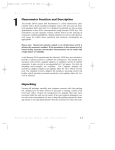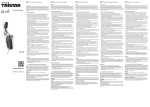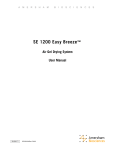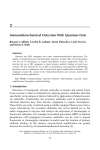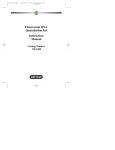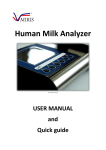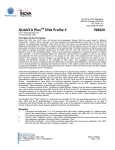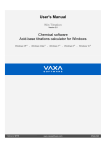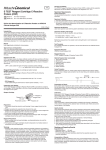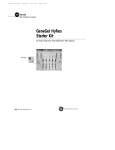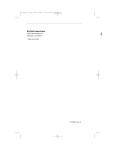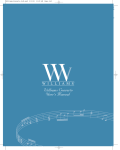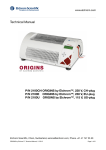Download Capillary Cuvette Adaptor Kit
Transcript
DQ130 um.qxd 2/6/2001 4:12 PM Page cvr1 user manual fluorometry Capillary Cuvette Adaptor Kit an accessory to the Hoefer DyNA Quant 200 um 80-6232-19/Rev. C1/02-01 DQ130 um.qxd 2/6/2001 4:12 PM Page 1 Page finder Capillary Cuvette Adaptor Kit Function . . . . . . . . . . . . . . . . . . . . . . . . . . . . . . . .2 Fluorescence measurement . . . . . . . . . . . . . . . . . . . . . . . . . . . . . . . . . . . . . . . . . . . .3 Measurement considerations Method overview Solutions Setup 4 .......................................... 5 ....................................................... 6 ................................................................ 8 .................................................................... Troubleshooting 12 ....................................................... Care and maintenance . . . . . . . . . . . . . . . . . . . . . . . . . . . . . . . . . . . . . . . . . . . . . . . .14 Customer service information Important user information 15 ........................................ 16 ........................................... • p1 DQ130 um.qxd 2/6/2001 4:12 PM Page 2 Capillary Cuvette Adaptor Kit Function The Capillary Cuvette Adaptor Kit adapts the Hoefer™ DyNA Quant™ 200 Fluorometer to accurately quantitate as little as 1 ng of DNA in a volume of 3 µl. The capillary cuvette fits into the DyNA Quant cuvette well. A capillary containing 3 to 9 µl of sample is inserted into the cuvette and a measurement is taken. Important! m Hoechst 33258 dye is a possible carcinogen and possible mutagen. • • • • Wear gloves when handling. Wear a mask when weighing. Comply with all applicable disposal regulations. Never dispose of by pouring into a drain. Because these measurements are highly sensitive, take extra steps to assure clean materials and reagents: • • • • • Use sterile pipette tips and sample tubes Make TNE buffer with double-distilled sterile water Filter buffers and water before adding H33258 Use only highly pure chemicals Wear gloves Periodically clean the optical surfaces of the capillary cuvette as described in the care and maintenance section. Use only ethanol. capillaries (250, glass, 9 µl) Fig 1. Capillary Cuvette Adaptor Kit components. capillary cuvette allen wrench for disassembling the cuvette um 80-6232-19 • p2 DQ130 um.qxd 2/6/2001 4:12 PM Page 3 Fluorescence measurement Bisbenzimide, commonly known as Hoechst 33258 (H33258) dye, exhibits changes in fluorescence characteristics in the presence of DNA that allow accurate DNA quantitation. In the absence of DNA, the excitation spectrum of H33258 peaks at 356 nm and the emission spectrum peaks weakly at 492 nm. When H33258 binds to DNA, these peaks shift to 365 nm ex and 458 nm em. In the cuvette well the sample is exposed to filtered light (365 ± 7 nm) from a mercury lamp. This light excites the DNA-dye complex, causing light that peaks at 458 nm to be emitted. An emission filter in front of the the photodetector allows only fluorescence at 460 ± 15 nm to register. The measured fluorescence is thus a direct indicator of the DNA concentration. Fig 2. Cuvette insertion The capillary cuvette fits into the cuvette well oriented as shown below (Fig 2). Disposable 9 µl glass capillaries seat into the cuvette. Two quartz lenses focus the excitation beam on the sample and the emission beam on the detector. Mirrors reflect light to increase fluorescence intensity (Fig 3). front surface mirrors Fig 3. Interior and functional views of capillary cuvette. capillary the optical windows face toward the left and the keypad. emission beam quartz lenses excitation beam lenses mirrors capillary alignment seat tab • p3 DQ130 um.qxd 2/6/2001 4:12 PM Page 4 Measurement considerations Use 1X TE buffer to dilute ultrapure DNA standard or 1X TNE to dilute sample DNA and to make the assay solution. This solution ensures the optimal pH value (7.4) and maximum signal to noise ratio. Select the dye concentration appropriate to the expected DNA concentration to minimize artifacts. Excess unbound dye increases background fluorescence levels and can be a major source of uncertainty. Final DNA concentration (in the capillary tube) 2X capillary assay solution up to 10 ng/µl A (2 µg/ml H33258) 10 to 100 ng/µl B (20 µg/ml H33258) A simple way to ensure that the DNA sample is in 1X assay solution is to mix one part 2X capillary assay solution with one part DNA solution. Similarly, the “blank” solution used to zero the fluorometer must contain the same final dye concentration as the DNA samples: Mix one part 2X capillary assay solution with one part 1X TNE. The DNA reference standard (1 mg/ml solution of calf thymus DNA) serves both to provide a one-point reference for determining the DNA concentration of unknown DNA samples and as a standard to evaluate the performance of the fluorometer. Picogram sensitivity is possible when using highly purified samples and a high purity standard such as cesium chloride gradient purified DNA (80-6227-06) together with a low concentration of H33258. The DNA standard supplied with the unit is appropriate for quantitation above about 0.3 ng/µl DNA in the capillary tube. Generate a standard concentration curve for maximum accuracy. Analyze the results by graphing the sample concentration (x) vs the averaged reading (y). As long as the graph is linear you can expect accurate values for unknown samples within the range of the standard curve. (Slight variations are most commonly due to pipetting variability.) um 80-6232-19 • p4 DQ130 um.qxd 2/6/2001 4:12 PM Page 5 Method overview 1 Turn on the fluorometer lamp at least 15 min before using. 2 Prepare dilutions of standards and samples in microfuge tubes with lids. You will need one “blank” 1X capillary assay solution to zero the instrument, one standard solution in 1X capillary assay solution to calibrate the instrument (optional: a full series of standard concentrations for a standard curve), and DNA samples in 1X capillary assay solution. 3 Zero and calibrate the instrument. Optional: Measure a series of standard concentrations. Plot standard curve measurements to confirm linearity in the range of interest. 4 Measure fluorescence of the unknown DNA sample (in the same capillary assay solution used for the standard). If following the protocols as described, the actual concentration is displayed automatically. If deviating from the protocols by using different concentrations or dilutions, or a calibration value that is a multiple of the standard concentration, use mathematical tools such as graphing and linear regression analysis to determine the concentration. • p5 DQ130 um.qxd 2/6/2001 4:12 PM Page 6 Solutions Important! Refer to the material safety data sheet (MSDS) accompanying each chemical for detailed handling and safety information. Hoechst 33258 stock dye solution (1mg/ml) H33258 distilled or deionized water 10 mg 10 ml Do not filter. Store in an amber bottle at 4 °C for up to 6 mo. 10X TE buffer stock solution (100 mM Tris, 10 mM EDTA) 100 ml Dissolve into 80 ml of distilled or deionized water: Tris base [Tris (hydroxymethyl) aminomethane], MW=121.14 EDTA, disodium salt, dihydrate, MW=372.20 1.21 g 0.37 g Adjust pH to 8.0 with concentrated HCI. Add distilled or deionized water to 100 ml. Store at 4 °C for up to 3 mo. 10X TNE buffer stock solution (100 mM Tris, 10 mM EDTA, 2 M NaCl) 1 000 ml Dissolve into 800 ml of distilled or deionized water: Tris base [Tris (hydroxymethyl) aminomethane], MW=121.14 EDTA, disodium salt, dihydrate, MW=372.20 Sodium chloride, MW=58.44 Adjust pH to 7.4 with concentrated HCl. Add distilled or deionized water to 1 000 ml. Filter before use (0.45 µm). Store at 4 °C for up to 3 mo. um 80-6232-19 • p6 12.11 g 3.72 g 116.89 g DQ130 um.qxd 2/6/2001 4:12 PM Page 7 Calf thymus DNA (100 µg/ml) 1:10 dilution of standard; may require further dilution calf thymus DNA standard, 1 mg/ml 10X TE distilled or deionized water 100 µl 100 µl 800 µl Gently tap the tube to mix thoroughly. Store at 4 °C for up to 3 mo. 2X Capillary assay solution A (2 µg/ml H33258 in 1X TNE, pH 7.4) for up to 10 ng/µl final DNA concentration H33258 stock solution 10X TNE distilled or deionized water 2 µl 100 µl 898 µl Prepare fresh daily. Keep at room temperature. Do not filter once the dye is added. 2X Capillary assay solution B (20 µg/ml H33258 in 1X TNE, pH 7.4) for ≈10 to 100 ng/µl final DNA concentration H33258 stock solution 10X TNE distilled or deionized water 20 µl 100 µl 880 µl Prepare fresh daily. Keep at room temperature. Do not filter once the dye is added. • p7 DQ130 um.qxd 2/6/2001 4:12 PM Page 8 Set up Since the fluorescence assay for DNA is a relative but linear function of the amount of DNA present, a single known DNA concentration suffices for calibrating the assay. Once this calibration value can be reliably reproduced, you can proceed to determining the concentration of the unknown samples, or determine the assay linearity with standard dilutions. Generating a standard curve once every few weeks serves as a quality check on the standard, a reliability check on the instrument, and a consistency check on technique. Note: Turn the prompt mode off when using the capillary adapter. (Select 2> Setup, 1> Prompt, and select 1> Off.) 1 Turn on the fluorometer lamp at least 15 min before taking measurements so it has time to stabilize. 2 Prepare solutions for measurement in microfuge tubes. Prepare a minimum of 10 µl total. Keep lid closed between measurements to prevent evaporation. Blank Mix equal volumes of 1X TNE and the appropriate 2X capillary assay solution. Standard For a standard solution with a final concentration of 10 ng/µl DNA, dilute a 20 ng/µl solution (prepared in 1X TNE) 1:1 with 2X capillary assay solution A. For a standard solution with a final concentration of 100 ng/µl DNA, dilute a 200 ng/µl solution (prepared in 1X TNE) 1:1 with 2X capillary assay solution B. Sample Prepare sample so that the final TNE concentration is 1X. Dilute sample solution 1:1 in the appropriate 2X capillary assay solution. um 80-6232-19 • p8 DQ130 um.qxd 2/6/2001 4:12 PM Page 9 3 Place the capillary cuvette in the cuvette well. Orient the cuvette so that the optical windows face toward the left and the keypad. (See Fig 2 on page 3.) Seat the cuvette into the well and leave in place until all measurements are taken. Inserting a capillary into the adapter: If not familiar with the cuvette, practice inserting a few dry capillaries: Invert the capillary container and gently shake one capillary out of the cap opening. Capillaries are fragile; handle with care. Do not handle the end that will be inserted into the sample solution. Gently insert the capillary into the cuvette opening. Carefully lower or twist the tube into the conical depression at the bottom until the capillary seats. When seated properly, about 4 mm of the capillary protrudes above the cuvette. Zero the instrument 1 Fill the capillary “blank.” Place one end of the capillary into the “blank” solution until it is about half full. (Each tube holds 9 µl; a minimum of 3 µl is required.) Tilt the tube into a horizontal position if necessary. 2 Dry the outside of the tube with a tissue, taking care to not wick the solution out of the bottom. Insert the capillary into the cuvette. 3 Close the lid, and press <ZERO>. • p9 DQ130 um.qxd 2/6/2001 4:12 PM Page 10 Set a reference point with DNA standard 1 Fill a capillary containing the appropriate DNA standard. We suggest using a DNA concentration higher than the expected concentration of the unknown sample. For example, for low range concentrations (up to 10 ng/µl), use 10 ng/µl DNA standard to calibrate the instrument. (Dilute 5 µl of 20 ng/µl standard with 5 µl of capillary assay solution A.) For example: If your standard contains 10 ng/µl DNA and you enter 100, each unit then corresponds to 0.1 ng/µl DNA in the capillary tube. 2 Insert the capillary with the standard solution into the cuvette, close the lid, and press <CALIB>. Enter the actual concentration of the standard or enter a convenient value that will display a multiple of the actual DNA concentration. Press <ENTER>. 3 If desired, measure a second capillary with standard solution to verify that results are reproducible. One reference point is adequate to set the instrument. However, generating a standard concentration curve assures assay linearity in the range of interest. A set of solutions for a curve in the 0 to 10 ng/µl range is described in the next section. Construct a standard concentration curve 1 Prepare a set of standard dilutions. This example applies to DNA concentrations of 0 to 10 ng/µl in 10 µl total. First prepare the DNA standard in 1X TE: Use a 1:50 dilution (in 1X TNE) of the 1 mg/ml DNA standard for a 20 ng/µl working solution. Then dilute 1:1 with 2X capillary solution A for enough solution for two readings. um 80-6232-19 • p10 Desired final DNA conc, ng/µl 0 2 4 6 8 10 µl DNA solution, 20 ng/µl (1:50 dilution) 0 1 2 3 4 5 1X TNE, to 5 µl total 5 4 3 2 1 0 Capillary assay solution A, µl 5 5 5 5 5 5 DQ130 um.qxd 2/6/2001 4:12 PM Page 11 2 Measure a sample for each concentration. If desired, measure a second sample and average the readings. 3 Plot the data or enter it into a math program to find the linear best fit equation of the line passing through the points. (See the DyNA Quant 200 instructions, Section 4 “Analyze the results” for more detail.) Measure unknown DNA concentration 1 Fill the capillary approximately halfway with sample solution diluted with the appropriate capillary assay solution. A minimum of 3 µl is required. 2 Insert the capillary into the cuvette. Close the lid and record the reading. Depending on how the instrument was calibrated, the display shows either the actual DNA concentration in the capillary tube or a multiple of the concentration. If the reading is above the concentration curve linear range, dilute an aliquot of the original sample and repeat the assay (Step 1). Or, if using capillary assay solution A, repeat the assay using capillary assay solution B. 3 Determine the concentration from the standard concentration curve or calculate the concentration from the equation of the line. (See the DyNA Quant 200 instructions, Section 4 “Analyze the results” for more detail.) • p11 DQ130 um.qxd 2/6/2001 4:12 PM Page 12 Troubleshooting problem remedy Always be sure to: Operate the unit in a location isolated from equipment that radiates high-frequency electromagnetic interference. Operate the unit away from direct sunlight. Place the instrument so that the back vents are not obstructed. Take care to not damage the optical surfaces when removing broken glass from the cuvette. When reassembling the cuvette, do not force the screws. Capillaries break Practice installing dry capillaries. Use a light touch; gently twist the tube as you seat it into place. Usually it drops into place without help. Fluorescence values drift Assay solutions must be at ambient temperature for consistent readings. (Fluorescence decreases as temperature increases.) Protect fluorescent reagents and samples from light to prevent photobleaching (destruction of the fluorescent compound by light). Take readings immediately. Fluorescence measurement is subject to photobleaching. Assay solutions must be at pH 7.4. Adjust the salt concentration in the assay solution. For standard DNA extraction, the concentration should be at least 200 mM NaCl in 1X TNE. For crude cell lysates, use 2 to 3 M NaCl in 1X TNE. If air bubbles are present, the reading will first drift upward as light is scattered by the bubbles until they move out of the beam range or dissipate. If particulates are present, the reading may suddenly rise as a particle drifts into the light path and then drop as it moves out of the beam range. Wide fluctuations in fluorescence values Thoroughly mix the sample and assay solution. Use a micropipet accurate to at least 0.02 µl. If inconsistencies persist, dilute the sample and use larger aliquots. Take care that the DNA sample is completely suspended. Use only pure distilled and filtered (0.2 or 0.4 µm filter) water for all solutions. um 80-6232-19 • p12 Filter the 1X TNE buffer to remove all particulates. Particles scatter light, causing measurement fluctuations. (Filter the buffer before adding H33258 dye because the dye binds to most membrane types.) DQ130 um.qxd 2/6/2001 4:12 PM Page 13 problem remedy Readings negative or lower than expected Use freshly prepared assay solution at ambient temperature to set the zero and for all subsequent measurements. (Fluorescence decreases as temperature increases, so setting the zero with a cool solution results in a lower unknown sample reading, especially if the sample is at a low concentration.) Use an ultra-pure grade DNA standard. Extract ethidium bromide from DNA solutions because it interferes with the fluorescence of H33258 dye. If expected DNA values are based on A260/A280 readings, the sample may be contaminated with RNA, nucleotides, or protein, which are not detected by H33258 fluorescence. Crude cell lysates prepared with acid guanidinium thiocyanatephenol solution: Fluorescence of lysates prepared without an alkaline EDTA pretreatment is reduced by 70% compared to lysates with such pretreatment. Alkaline conditions allow formation of complexes between DNA and the dye. For a detailed protocol see: Rymaszewski, et al, (1990) Estimation of cellular DNA content in cell lysates suitable for RNA isolation. Anal. Biochem. 188, 91–96. Use the appropriate reference standard Make sure to use a standard with a G-C content very similar to the sample DNA. H33258 binds preferentially to A-T regions, so G-C content must be similar to ensure “equivalent” binding. Use a ssDNA standard for ssDNA samples. (Single-stranded DNA yields about half the fluorescence of an equal amount of double-stranded DNA.) Plasmid DNA standards should have the same conformation as the sample. Each form—supercoiled or relaxed, circular or linear—may have slightly different dye binding characteristics. Readings higher than expected Fluorescence enhancement may result from high levels of detergents. Final SDS concentration should be below 0.01%, final Triton X-100 concentration below 0.001%, and other detergents below 10 µg/ml. (The final concentration of any detergent should be well below its critical micelle concentration.) Use a reference standard with a G-C content very similar to that of your sample. For plasmid DNA, use a standard with the same conformation as the samples being measured. • p13 DQ130 um.qxd 2/6/2001 4:12 PM Page 14 Care and maintenance The cuvette can be easily disassembled for cleaning (see Fig 4). Clean the cuvette periodically or if a spill occurs inside the cell. 1 Use the provided 5/64" hex key to remove the two small screws near the top of the cuvette. Carefully slide the now free section up so that it clears the plastic tab at the bottom. 2 If a capillary is broken, take care not to scratch the optic surfaces when removing the pieces. Gently brush away any remaining fragments with a soft cloth, brush, or cotton swab. Soak up any spilled liquid. 3 If necessary, clean both mirrors and the lenses with ethanol only. Other solvents can damage the components. Wet the surface by spraying ethanol (preferred method) and wiping with a soft cloth or cotton swab. Alternatively, dampen the cloth or swab with ethanol and then wipe. 4 When assembling the cleaned cuvette, carefully align the bottom tab so that it engages the slot in the back face. Replace the screws and secure just enough to hold the cuvette together. Do not force the screws. Fig 4. To disassemble, remove both screws. Then lift the released cuvette section first up, and then away. screws lenses mirrors tab um 80-6232-19 • p14 capillary alignment seat tab DQ130 um.qxd 2/6/2001 4:12 PM Page 15 Customer service information Important! Decontaminate instrument of all radioactivity and/or infectious agents before returning item! Include documentation to verify that this has been done. Technical service and repair Amersham Biosciences offers complete technical support for all our products. If you have any questions about how to use this product, or would like to arrange to repair it, please call or fax your local Amersham Biosciences representative. Ordering information Hoefer DyNA Quant 200 Fluorometer 115/230 VAC Glass fluorometry cuvette, fluorescent grade Lamp replacement assembly Optics replacement kit Lid replacement assembly Capillary Cuvette Adaptor Kit Includes one capillary cuvette, 250 9 µl glass capillary tubes with dispenser, and 5/64" Allen key Capillary tubes, 9 µl, glass Dye and Standards Hoechst 33258 dye Calf thymus DNA, fluorescence standard 4-MU Standard Kit. 4-methylumbelliferone Performance Validation Kit quantity code number 1 1 1 1 1 80-6406-80 80-6227-44 80-6228-96 80-6229-34 80-6229-53 1 80-6228-39 250 80-6228-58 100 mg 250 µg 100 mg 1 80-6226-87 80-6227-06 80-6227-25 80-6252-52 • p15 DQ130 um.qxd 2/6/2001 4:12 PM Page 16 Important user information Should you have any comments on this manual, we will be pleased to receive them at: m Amersham Biosciences Inc. Marketing Department 654 Minnesota Street San Francisco, CA 94107-3027 Note: Please read this entire manual to fully understand the safe and effective use of this product. Amersham Biosciences reserves the right to make changes in the specifications without prior notice. Warranty and liability Amersham Biosciences guarantees that the product delivered has been thoroughly tested to ensure that it meets its published specifications. The warranty included in the conditions of delivery is valid only if the product has been installed and used according to the instructions supplied by Amersham Biosciences. Amersham Biosciences shall in no event be liable for incidental or consequential damages, including without limitation, lost profits, loss of income, loss of business opportunities, loss of use and other related exposures, however caused, arising from the faulty and incorrect use of the product. um 80-6232-19 • p16 F Amersham Biosciences garantit à l’utilisateur que le produit livré a subi avec succès tous les essais prévus pour s’assurer qu’il est conforme aux spécifications et normes en vigueur. La garantie incluse dans les conditions de livraison n’est valable que si le produit a été installé et utilisé conformément aux instructions fournies par Amersham Biosciences. La société Amersham Biosciences ne sera en aucun cas responsable de tout dommage causé directement ou indirectement par toute utilisation incorrecte ou non approuvée du produit ou découlant de cette utilisation, y compris toute perte de bénéfice ou de recettes, toute perte de perspectives commerciales, tout empêchement d’utilisation et tout autre risques ayant un rapport avec l’utilisation du produit, mais sans aucune limitation quant à la nature de ces dommages. E Amersham Biosciences garantiza que el producto entregado ha sido probado a fondo para comprobar el cumplimiento de las especificaciones publicadas. La garantía incluida en las condiciones de entrega sólo es válida si el producto se ha instalado y utilizado de acuerdo con las instrucciones entregadas por Amersham Biosciences. Amersham Biosciences no será responsable, bajo ningún concepto, de daños directos o indirectos, incluyendo sin limitación la pérdida de beneficios, la pérdida de ingresos, la pérdida de oportunidades de negocio, la pérdida de utilización y otras consecuencias relacionadas, cualquiera que sea la causa, que se deban a la utilización defectuosa e incorrecta del producto. D Amersham Biosciences garantiert, daß das gelieferte Produkt sorgfältig auf die Einhaltung der veröffentlichten Spezifikationen getestet wurde. Die in den Lieferbedingungen näher erläuterten Gewährleistungsansprüche gelten nur dann, wenn das Produkt gemäß den von Amersham Biosciences gelieferten Anweisungen installiert und benutzt wurde. Amersham Biosciences übernimmt keinerlei Haftung für Schäden oder Folgeschäden, einschließlich, aber nicht begrenzt auf Gewinneinbußen, Einkommensverluste, entgangene Geschäftsabschlüsse, Verlust der Gebrauchsfähigkeit oder andere Verluste, die wie auch immer durch eine fehlerhafte oder unsachgemäße Verwendung des Produkts verursacht wurden. I Amersham Biosciences garantisce che prima della consegna il prodotto è stato collaudato a fondo per soddisfare i requisiti specificati. La garanzia inclusa nelle condizioni di consegna risulta valida solamente se il prodotto è stato installato ed utilizzato nel rispetto delle istruzioni fornite da Amersham Biosciences. Amersham Biosciences non potrà essere ritenuta responsabile di incidenti o danni consequenziali, inclusi’ma non limitati’a perdite di profitti, mancato guadagno, perdite di affari, difetti di funzionamento e relative esposizioni, dovuti ad un utilizzo non corretto del prodotto. DQ130 um.qxd 2/6/2001 4:12 PM DyNA Quant and Hoefer are trademarks of Amersham Biosciences Limited or its subsidiaries. Amersham and Amersham Biosciences is a trademarek of Amersham plc. © 2001 Amersham Biosciences Inc. All rights reserved. All goods and services are sold subject to the terms and conditions of sale of the company within the Amersham Biosciences group that supplies them. A copy of these terms and conditions is available on request. Printed in the USA. Amersham Biosciences UK Limited Amersham Place Little Chalfont Buckinghamshire England HP7 9NA Amersham Biosciences AB SE-751 84 Uppsala Sweden Amersham Biosciences Inc. 800 Centennial Avenue PO Box 1327 Piscataway NJ 08855 USA Amersham Biosciences Europe GmbH Munzinger Strasse 9 D-79111 Freiburg Germany www.amershambiosciences.com Page 18



















